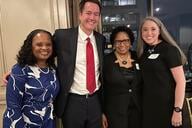You have /5 articles left.
Sign up for a free account or log in.
In a recent tweet, Campus Sonar’s Liz Gross endorsed a colleague’s argument for investing in social media. She said, “Yes. And if we're willing to spend money on billboards and airport advertising, we should certainly be willing to spend money on social media....which is often actually trackable.”
Ah yes, out-of-home advertising (OOH) – especially billboards and airport ads – a seeming favorite medium among higher education institutions. Whether I’m driving through a big city or strolling through an airport, college and university ads always make travel more interesting. I’ll admit it’s easy to play armchair marketer and question the tactic or critique the creative.
We’ve heard about the pros and cons of outdoor advertising, and there’s credence to both perspectives. I’ll borrow some advice from a few sage marketers and provide three considerations for higher ed OOH.
Who’s it for, and what’s it for?
These words from Seth Godin ring true in many cases and certainly do in this discussion. Who are we seeking to change, and what change are we trying to make? By the way, that’s a lot to ask of a billboard or of any advertising. Yes, billboards are seen by the masses (so no OOH ads for specific degree programs, please), but we should still be able to convincingly answer these two fundamental, audience-centric questions.
The University of Melbourne’s “Made Possible by Melbourne” campaign is a terrific example. UM innovatively used OOH to create interactive exhibits, showcasing to their own community how the university’s scientific research enriches Australia and the world. Who it’s for, and what it’s for.
Everything is connected to everything else.
This “first law of branding” never goes out of style. Channels can rarely do all the heavy lifting on their own. In an omni-channel environment, integration wins. Thus, we need to move away from assessing OOH in a vacuum. A common criticism of OOH advertising is that it’s not trackable. A valid question, but are we tracking how other channels – ones we can better measure – perform when brand marketing such as OOH is activated?
Even though we all may see an institution’s outdoor advertising (and we may not see its targeted digital advertising), we must keep in mind that the OOH is likely playing a supporting – not leading – role, giving a lift to other channels across an integrated campaign. In fact, OOH accounted for an estimated 11 percent of higher ed advertising allocations in 2017, while digital was approaching 50 percent (per Educational Marketing Group and Kantar Media).
What you measure matters, but what’s hard to measure might matter more.
This tenet from Bernadette Jiwa is a useful reminder as we constantly have more data at our fingertips and invest more time and resources – as we should – gaining insights from it. There are many important touchpoints that we can’t fully or adequately measure.
One example from my institution is an ad buy each August at the Indianapolis International Airport: a “Welcome Home, Hoosiers” message to greet international students coming to campus for the fall semester. Accompanying the banner is an Indiana University booth, staffed by students to welcome fellow students, assist them with their next steps, and show them that IU cares. The consistent feedback from international students is one of gratitude. Hard to measure, but definitely worth it.
Rob Zinkan is associate vice president, marketing, at Indiana University in a system-wide role. In his 16 years there, he has also served as vice chancellor for external affairs and assistant dean for advancement at two different IU campuses.




